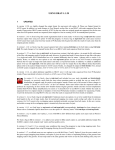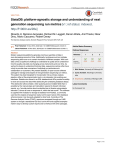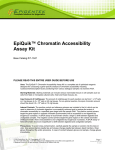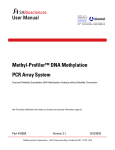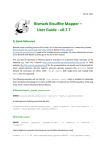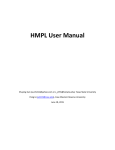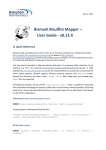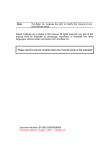Download brat user manual 1 2 1
Transcript
USING BRAT-1.2.1 This new version has a different input and output formats to enable BRAT to identify copy-duplicates (the reads mapped to the same location in the genome). A new tool remove-dupl chooses and keeps a randomly chosen representative of copyduplicates and removes the rest of copy-duplicates. 1 ANALYSIS PIPELINE Currently BRAT includes the following tools: brat, brat-large, brat-large-build, acgt-count, trim, rev-compl, check-strands and remove-dupl. The flow of the analysis pipeline is given in the figure below. Reads in FASTQ trim References in FASTA checkstrands brat or brat-large Mapped results Unmapped reads Are reads sequenced only from 2 original genomic strands? removedupl No rev-compl acgt-count brat or brat-large Methylome First, tool trim takes reads in FASTQ format, trims low-quality bases from both ends as well as Ns and outputs reads in raw reads format that are accepted by brat and brat-large. After trim, brat or brat-large are used to map the reads to the reference genome. If the reads are sequenced from four PCR-product strands, then rev-compl is used to take reverse-complements of the unmapped reads followed by mapping of the results with brat or brat-large. Next, mapped results are used as input for remove-dupl that removes copy-duplicates keeping only a randomly chosen one, where copy-duplicates are the reads that are mapped to the same start position in the reference. Finally acgt-count processes all the mapped results to produce methylome, a map with methylation status of each cytocine. Tool check-strands is used for information on ACGTdistribution in the reference and input reads. 2 SYSTEM AND SPACE REQUIREMENTS BRAT stands for Bisulfite-treated Reads Analysis Tool. There are two versions of BRAT: BRAT and BRAT-large. Both programs run on 64-bit architecture under Linux/Unix operating system. Both versions work with reads of lengths 24 bases and above. BRAT accepts up to 4.2G references with total size of references up to 4.2G base pairs. BRAT-large can work with up to 4.2G references with the size of the largest reference up to 4.2G base pairs. BRAT works best with relatively small genomes because it uses significantly more space than BRAT-large. BRAT is faster than BRAT-large that maps reads to the references sequentially: it maps all reads to the first reference, then all reads to the second reference and so on. The space requirement of BRAT-large depends on the size of the largest reference in the set of input references, whereas BRAT’s space requirement depends on the total size of all input references (measured in base pairs). Let N be the total size of a genome in base pairs, T be the size of the largest reference in base pairs and R be the total number of reads (each read is counted, i.e. a pair has 2 reads). Then the space required for both programs is bound as follows: SpaceBRAT = 269 ⋅ 106 + 2⋅4N + 24R + (3/8)N SpaceBRAT-large = 269 ⋅ 106 + 4T + 24R + (3/8)T SpaceBRAT-large = 269 ⋅ 106 + 2⋅4T + 24R + (3/8)T Bytes Bytes Bytes (when option S is provided) Whenever there is a space limitation, the user can choose to use BRAT-large. Here is an example of space usage with pairedend BS-mapping with non-BS-mismatches (mismatches other than T-to-C and A-to-G): BRAT uses 2.5 GB on 1 million pairs and human chromosome 1, and BRAT-large on 10 million pairs and an entire human genome uses 1.7 GB (or 2.7GB with option S). In this version, BRAT allows for non-BS-mismatches with the restriction on the number of non-BS-mismatches in the first X bases (for BRAT) and X bases (for BRAT-large), where X is a threshold specified with the option f (X cannot be smaller than 24 or larger than 64). BRAT guarantees to map all reads that could be mapped to the genome with up to one non-BSmismatch in the first X bases of reads. A user can specify any number of non-BS-mismatches with the option m, and as long as there is only one non-BS-mismatch in the first X bases of a read, BRAT will map this read. BRAT-large does not allow for non-BS-mismatches in the first X bases of reads. If a user specifies any number of non-BS-mismatches with the option m, BRAT-large will map all reads that could be mapped perfectly or with BS-mismatches within the first X bases, and any number of non-BS-mismatches in the other bases of reads. The package includes three additional tools: trim, brat-large-build and acgt-count. The latter aligns mapped reads to the genome and counts mapped nucleotides at each base for forward and reverse strands separately. The tool trim accepts FASTQ files with reads/pairs as input, trims the ends of the reads whose base quality scores are lower than the user specified threshold and trims Ns at the ends of the reads. The tool brat-large-build is used with option P with BRAT-large. 3 COMMANDS AND INPUT To uncompress run: tar zxvf brat-1.2.*.tar.gz To build: cd brat-1.2.* make This will create executable programs: brat-large, brat-large-build, acgt-count, trim, rev-compl, check-strands and removedupl. Input format of the reads for BRAT and BRAT-large is raw reads: • Read < string >: a read after using trim; • Start <int>: the number of bases trimmed at the beginning of the original read; • End <int>: the number of bases trimmed at the end of the original read. To convert reads from FASTQ format to raw reads, one should run trim. If a user does not wish to trim reads’ low quality score bases, then he/she should omit the option for the base quality score threshold: the default threshold equals to zero, so all reads will be in the output without change in lengths (except for reads having Ns at the ends). If reads have Ns at the ends, trim trims Ns at the ends and outputs only those reads whose length after trimming is greater or equal to 24 bases. A command to run trim This program trims low-quality bases (lower than a threshold given with option -q) and Ns from each end of a read: bases are trimmed one at a time from both ends of a read until a base with quality score greater or equal than q is encountered (similarly, all consecutive Ns from both ends of a read are trimmed). This tool outputs only those reads whose length is at least 24 after trimming and that have at most m internal Ns: the number of allowable internal Ns is set by option -m. To trim single-end reads in the file reads.fastq in FASTQ format and output trimmed raw reads into a file with name prefix_reads1.txt, run the command: ./trim -s reads.fastq -P prefix -q 20 -L 64 -m 2 This will trim bases whose base quality scores are lower than 20 from the ends of reads. The option L specifies the smallest value of the range of base quality scores in ASCII representation (please see Commands Options for details). To learn more about Phred scores, please visit http://www.phrap.com/phred/. Option -m allows each read having at most 2 internal Ns. Option -P provides prefix to the output file names (it might contain a path for an output file: -P /home/directory/prefix). If the user does not wish to trim ends with low base quality scores, the -q option is not specified. For single-end reads, there is a single output file with trimmed reads. To trim paired-end reads in the files reads1.fastq and reads2.fastq in FASTQ format, run the command: ./trim -1 reads1.fastq -2 reads2.fastq -P prefix -q 20 -L 64 -m 2 Here we assume, that reads1.fastq contains sequenced 5` mates, and reads2.fastq contains sequenced 3` mates. The output will be in four files with raw reads: prefix_reads1.txt, prefix_reads2.txt, prefix_mates1.txt and prefix_mates2.txt. To further map paired-end reads, use prefix_reads1.txt and prefix_reads2.txt as input files for paired-end mapping with brat or brat-large. The file prefix_mates1.txt contains reads from the file reads1.fastq whose mates have shorter length than 24 bases after trimming. Similarly, the file prefix_mates2.txt contains reads from the file reads2.fastq whose mates are shorter than 24 bases. The user can further map these files, prefix_mates1.txt and prefix_mates2.txt, as single-end reads: for BS-mapping of the reads in prefix_mates2.txt, the user must specify -A option for mapping to work correctly (the same is true if a user wishes to map the reads in prefix_reads2.txt as single reads). Additional output files are prefix_pair1.fastq, prefix_pair2.fastq, prefix_mates1.fastq and prefix_mates2.fastq. These files have the same reads as do files prefix_reads1.txt, prefix_reads2.txt, prefix_mates1.txt and prefix_mates2.txt respectively, except the files prefix_pair1.fastq, prefix_pair2.fastq, prefix_mates1.fastq and prefix_mates2.fastq are in FASTQ format. NOTE: current version of BRAT and BRAT-large do NOT support FASTQ format. These additional files are for users to track original reads’ names and corresponding base quality scores. Commands to run brat and brat-large BRAT and BRAT-large map raw reads (output from trim) to references that have to be in FASTA format: one reference per FASTA file. BRAT accepts a single file that contains names of FASTA files with the references. To map bisulfite single- end reads, run either of the commands: ./brat -r references_names.txt -s prefix_reads1.txt -bs -o output_results.txt ./brat-large -r references_names.txt -s prefix_reads1.txt -bs -o output_results.txt ./brat -r references_names.txt -s prefix_reads2.txt -bs -o output_results.txt -A ./brat-large -r references_names.txt -s prefix_reads2.txt -bs -o output_results.txt -A The file references_names.txt contains the names of the FASTA files with the references. The file output_results.txt contains the results of the mapping: only uniquely mapped reads are in this file. The option -bs specifies that mapping is for bisulfite sequenced reads. To map normal (not bisulfite-treated) reads, run similar commands but without -bs option: ./brat -r references_names.txt -s prefix_reads1.txt -o output_results.txt ./brat-large -r references_names.txt -s prefix_reads1.txt -o output_results.txt To map bisulfite paired-end reads, run either of the following commands: ./brat -r references_names.txt -1 prefix_reads1.txt -2 prefix_reads2.txt -pe -bs -o output_results.txt ./brat-large -r references_names.txt -1 prefix_reads1.txt -2 prefix_reads2.txt -pe -bs -o output_results.txt The option -pe specifies paired-end mapping and as with single-end reads, -bs, specifies bisulfite mapping. The results of the mapping will be in output_results.txt. One can choose to pre-build genome index first and then use brat-large on this index to speed up mapping. Use option -P and tool brat-large-build: ./brat-large-build -r references_names.txt -P some_directory [options: S, bs, f ] ./brat-large -P some_directory -1 prefix_reads1.txt -2 prefix_reads2.txt -pe -o output_results.txt [options] To use this option that allows to separate hashing of the genome from mapping of reads, one has to create a directory, some_directory (the name of a directory in the example above), and to run the following commands (1) to build a hashing index and 2) to map reads. If the directory some_directory is the directory inside the directory in which you run the commands above, then providing the name, some_directory, is sufficient. However, if you run these commands in the directory that does not have some_directory in it, then please provide a full path to some_directory. The tool brat-large-build will output hashing index of the references into some_directory. For human genome, space on hard disk for hashing index is 15GB (and 26GB when option S is used). The command for tool brat-large with option P differs only by not specifying option r. If option bs was passed to brat-large-build, then this option must be passed to bratlarge. In other words, for mapping normal and bisulfite-treated reads, two different hashing indices must be built. The same true when option S is used: if a user wishes to use this option and P option, then S must be used with brat-large-build. When P is used, during mapping option f will have the same value that was set with brat-large-build. If a user does not specify this option, the default value, 24, will be used. If a user wishes to speed up mapping time, and to use option P, then the user could set option f to a higher value with brat-large-build. General rule for using option P: if a user wishes to change either of the parameters: f, S or bs; the user must apply the same parameters with brat-large-build. Default options for brat-large-build are f = 24, S is not set (i.e. preference is given to slower mapping, but also smaller space usage), and normal mapping (i.e. bs is not set). Commands Options: -A specifies 3`mates (in our examples above, either of prefix_reads2.txt or prefix_mates2.txt files must be used with this option). If the user does not specify this option, and provides either of the files, prefix_mates2.txt or prefix_reads2.txt, as input reads for single-end mapping, the mapping will NOT be correct; -u is used when a user wishes to output unmapped reads. The output will be in prefix_reads1.txt.unm file (assuming prefix_reads1.txt was provided in the command line with option -s) for single reads and with paired-end reads in prefix_reads1.txt.unm and prefix_reads2.txt.unm files (if prefix_reads1.txt and prefix_reads2.txt were used with the options -1 and -2 in the corresponding command line). Unmapped reads in the output files are in raw reads format: <read, X, Y>, where X and Y are the number of bases trimmed from the beginning and end of original read respectively (there are no ambiguous reads/pairs in the files with unmapped reads); -s <single-end reads file>: to specify the file with input reads for single-end reads mapping; -1 <paired-end reads file>: to specify the file with 5` mates for paired-end reads mapping (in our example, prefix_reads1.txt). This option is also used with acgt-count; -2 <paired-end reads file>: to specify the file with 3` mates for paired-end reads mapping (in our example above, prefix_reads2.txt); This option is also used with acgt-count; -pe to specify paired-end reads mapping (default is false, i.e. single-end mapping); -bs to specify bisulfite sequenced reads mapping. Without this option, mapping will be done as for normal, not bisulfitetreated, sequenced reads; -i <positive integer>: to specify minimum insert size for paired-end mapping, the minimum distance allowed between the leftmost ends of the mapped mates on forward strand (default is 100); -a <positive integer>: to specify maximum insert size for paired-end mapping, the maximum distance allowed between the leftmost ends of the mapped mates on forward strand (default is 300); -o <string>: to specify the file with the results of mapping; -M is used when a user wishes to output ambiguous reads. The output will be in prefix_reads1.txt.amb for single reads and in prefix_reads1.txt.amb and prefix_reads2.txt.amb files with paired-end reads: a single read per line. This option does not output the mapping locations for ambiguous reads, but just the reads themselves; -m <integer>: the maximum number of non-BS-mismatches allowed by a user (default is 0). -f <integer>: the number of the first bases of a read, where the restriction on the number of non-BS-mismatches applies: for BRAT, only one non-BS-mismatch is allowed in the first <integer> bases, and for BRAT-large NO non-BS-mismatches are allowed in the first <integer> bases (for BRAT, default is 36, and for BRAT-large, default is 24). -S to specify speed mode for BRAT-large. Space usage with this option doubles, but running time is about three times faster. -P <directory name> To use this option that allows to separate hashing of the genome from mapping of reads. -L <integer>: the smallest value of the range of base quality scores in ASCII representation (default is 33). The table below gives examples of different quality scores and their range in ASCII representation (from Wikipedia). The option L uses the values in the “Smallest Value in ASCII representation” column. Type Smallest Score Phred quality score (Sanger format) Solexa/Illumina, 1.0 Soloexa/Illumina, 1.3+ Largest Score Smallest Value in ASCII representation Largest Value in ASCII representation 0 93 33 126 -5 62 59 126 0 62 64 126 -B: specifies the second option for output with acgt-count (please read Output format for acgt-count). A command to run remove-dupl This program processes the mapping results and removes copy-duplicates: it outputs all reads that are mapped to a unique genomic location and only a randomly chosen one out of copy-duplicates (the reads mapped to the same location). ./remove-dupl -r references_names.txt -p pairs_results.txt -1 single_results_mates1.txt -2 single_results_mates2.txt NOTE: the file pairs_results.txt does not contain the actual results, it contains the names of the files with the results for paired-end mapping, and similarly, single_results.txt file contains the names of the files with the actual results for single-end mapping. For example, the content of pairs_results.txt is: output_pairs_lane1.txt output_pairs_lane2.txt and the content of single_results_mates1.txt is: output_singles_mates1_lane1.txt output_singles_mates1_lane2.txt and the content of single_results_mates2.txt is: output_singles_mates2_lane1.txt output_singles_mates2_lane2.txt The output of remove-dupl are the files with the same names as before with additional extension “.nodupl”: output_pairs_lane1.txt.nodupl output_pairs_lane2.txt.nodupl output_singles_mates1_lane1.txt.nodupl output_singles_mates1_lane2.txt.nodupl output_singles_mates2_lane1.txt.nodupl output_singles_mates2_lane2.txt.nodupl For single-end mapping, run the following command: ./remove-dupl -r references_names.txt -s single_results.txt The file single_results.txt contains the names of the files with mapping results. Please note that the output files with extension “.nodupl” are opened with C++ “app” option (opens a file and appends output to the file’s content). This means that once you have run remove-dupl, you will have “.nodupl” files, and if you want for some reason to run remove-dupl on the same files (and possibly some additional files), you need to remove “.nodupl” files for the corresponding files first and only then re-run remove-dupl. For example, as in the example above, you run remove-dupl and obtain “.nodupl” files: output_pairs_lane1.txt.nodupl output_pairs_lane2.txt.nodupl output_singles_mates1_lane1.txt.nodupl output_singles_mates1_lane2.txt.nodupl output_singles_mates2_lane1.txt.nodupl output_singles_mates2_lane2.txt.nodupl Then you wish to add output_pairs_lane3.txt to pairs_results.txt: output_pairs_lane1.txt output_pairs_lane2.txt output_pairs_lane3.txt and to re-run remove-dupl on all files. Make sure your delete existent files with extension “.nodupl”: rm output_pairs_lane1.txt.nodupl rm output_pairs_lane2.txt.nodupl rm output_singles_mates1_lane1.txt.nodupl rm output_singles_mates1_lane2.txt.nodupl rm output_singles_mates2_lane1.txt.nodupl rm output_singles_mates2_lane2.txt.nodupl and only then run remove-dupl. If you don’t remove these files, you will have previous output plus new output (for example: if output_pairs_lane1.txt.nodupl had 100 lines, then re-running remove-dupl without removing this file will result in 200 lines). A command to run acgt-count To count mapped As, Cs, Gs and Ts at each base of forward and reverse strands of the references, use acgt-count. ./acgt-count -r references_names.txt -P prefix -p pairs_results.txt -s single_results.txt the file references_names.txt contains the names of FASTA files with the references, which are needed to calculate the sizes of the references. The output will be in two files per a reference: prefix_forw_aReference_name and prefix_rev_aReference_name. The option -p is to specify the results of paired-end mapping (if any), and -s is to specify the results of single-end mapping (if any). NOTE: the file pairs_results.txt does not contain the actual results, it contains the names of the files with the results for paired-end mapping, and similarly, single_results.txt file contains the names of the files with the actual results for single-end mapping. At least one of these options must be provided. The files whose names are listed in the files pairs_results.txt and single_results.txt must be in BRAT’s output format. To make this point clear, assume, a user ran brat on paired-end reads and had the output file with the results in output_pairs_results.txt; to run acgt-count, the user must store the name of this file in pairs_results.txt file and run acgt_count using pairs_results.txt (i.e. pairs_results.txt will have in this case one line, namely, output_pairs_results.txt). The command for this example is: ./acgt-count -r references_names.txt -P prefix -p pairs_results.txt Please note that if a user has paired-end reads (files with mates 1 and mates 2) and wishes to map the mates as single-end reads, then the user must provide names of the files with results for mates 1 and mates 2 separately using options -1 and -2. This will ensure unbiased ACGT-counting when reads are sequenced from two original genomic strands: ./acgt-count -r references_names.txt -P prefix -p pairs_results.txt -1 single_results_mates1.txt -2 single_results_mates2.txt To produce a more concise output, use option -B (choose an appropriate command from the commands below): ./acgt-count -r references_names.txt -P prefix -p pairs_results.txt -s single_results.txt -B ./acgt-count -r references_names.txt -P prefix -p pairs_results.txt -1 single_results_mates1.txt -2 single_results_mates2.txt -B This program takes care of overlapping mates: if two mates of a pair overlap, then ACGT-count is done only for one mate in the overlapped region. This program also takes care of producing un-biased ACGT-count from mates 2 (3` mates). Please see Details on ACGT-count section for details. A command to run rev-compl Please read subsection How to use BRAT with reads sequenced from four strands. A command to run check-strands Please read section Details on ACGT-count. 4 OUTPUT FORMAT Output format for brat and brat-large for single-end mapping • • • • • • • Read id < integer >: a consecutive number of a read in the reads input file that starts with 0; Read 1 < string >: the read given as in the input file (prefix_reads1.txt); Reference name < string >: a name of a reference to which the read is mapped (the first word following “>” in a FASTA file); Strand “+” if the read is mapped to forward strand, and “-“ if the read is mapped to reverse strand; Position < integer >: position within the reference starting with 0, where the read is mapped (the leftmost position on forward strand). The number of non-BS-mismatches <int> Original position <integer>: position within the reference starting with 0, where the original read is mapped (the leftmost position on forward strand), where original read is the read before its ends have been trimmed. For example, if the number of trimmed bases at the beginning of a read is 2, and the read is mapped to positive strand at the position 10, then original position is 10 – 2 = 8. If the number of trimmed bases at the end of a read was 3 and the reverse-complement of the read is mapped to the position 10 on positive strand, then original position = position – 3 = 10 – 3 = 7. The original positions are used to identify copy-duplicates. Output format for brat and brat-large for paired-end mapping • • • • • • • • • • Read id < integer >: a consecutive number of a read in the reads input file that starts with 0; Read 1 < string >: the first mate of a pair given as in the input file (prefix_reads1.txt); Read 2 < string >: the second mate of a pair given as in the input file (prefix_reads2.txt); Reference name < string >: a name of the reference to which the pair is mapped (the first word following “>” in a FASTA file); Strand “+” if 5` mate (from prefix_reads1.txt) is mapped to forward strand (consecutively, 3` mate, from prefix_reads2.txt, is mapped to reverse strand), and “-“ if the 5` mate is mapped to reverse strand (and 3` mate to forward strand); Position 1 < integer >: position within the reference starting with 0, where 5` mate is mapped (the leftmost position on forward strand); Position 2 < integer >: position within the reference starting with 0, where 3` mate is mapped (the leftmost position on forward strand). The number of non-BS-mismatches < integer >: the number of mismatches in the alignment for 5` mate The number of non-BS-mismatches < integer >: the number of mismatches in the alignment for 3` mate Original position 1 <integer>: original position for 5` mate (see definition of original position above) • Original position 2 <integer>: original position for 3` mate (see definition of original position above) Output format for acgt-count Starting with version brat-1.1.17, there are two choices for output format. The first choice: The number of output files will be double the number of input references: two for each reference listed in references_names.txt file (one file for forward strand and the other for reverse strand). In each file, there are M lines, where M is the size of a corresponding reference in base pairs. Each line corresponds to a base of a strand and contains counts for As, Cs, Gs and Ts at that base for all mapped reads (i.e. there are four integers per line: from left to right for As, Cs, Gs and Ts). For the reverse strand, the counts of As, Cs, Gs and Ts are given for the reads that are mapped to the reverse strand, but the counts are obtained by aligning the reverse-complements of these reads with the forward strand. Following is an example to illustrate this point. Let a read ACCGTT be mapped to a reverse strand at position i, then the corresponding forward strand starting at position i is AACGGT, and the counts for the reverse strand at positions i …i+5 from this read are incremented for the following nucleotides: i(A), i+1(A), i+2(C), i+3(G), i+4(G) and i+5(T). The second choice: If a user provides option -B: ./acgt-count -r references_names.txt -P prefix -p pairs_results.txt -s single_results.txt -B then the output is in two files: one file for positive strand and another for negative strand (output files will contain words “forw” and “rev” to distinguish between strands). Each line in the output corresponds to a base in the genome that is either a cytocine on positive strand or cytocine on negative strand (given in separate files). Output format: chrom, start, end, total, methylation_level, strand where chrom is the reference name, start and end are positions in the genome (Note: base count in a reference starts with 0), total takes one of the values: CHH:X, CHG:X or CpG:X, where X is the sum of counts of Cs and Ts mapped to this base, methylation level is calculated as the number of Cs over the total (methylation level = count_C/(count_C + count_T)). CHH, CHG and CpG describe the sequence content following C: if two consecutive bases that follow C are not G, then total = CHH:X; if the first consecutive base following C is non-G and the second consecutive is G, then total = CHG:X; and finally, if G follows C (we have CG di-nucleotide), then total = CpG:X. Output format for trim. The tool trim accepts FASTQ files with reads/pairs as input, trims the ends of the reads whose base quality scores are lower than the user specified threshold or whose ends are Ns. The output for single reads is a single file with reads whose lengths might be different and whose lengths are greater than or equal to 24 bases. The output for pairs is four files: two for pairedend mapping, and two for single-end mapping. Trimming of paired-end reads produces two files with single reads: if one mate is shorter than the minimum length allowed, and the other’s length is correct, then the mate with the correct length will be output into a corresponding file with single reads. Two files for single reads are necessary because BS-mapping for 5` and 3` mates is different. Each file contains a single line (raw reads format) with the following fields: • • • Read < string >: a read after using trim; Start <int>: the number of bases trimmed at the beginning of the original read; End <int>: the number of bases trimmed at the end of the original read. 5 DETAILS ON ACGT-COUNT COUNT Let us denote a mapping of a base in a read to a base in the reference as C C→C, → T→C, → A→G, → G→G. →G. Initially, we thought that if a read maps to a positive strand, then the mappings C C→C → and T→C →C contribute to the count of methylation methyla level of cytocines of the positive strand. Similarly, if the reverse reverse-complement complement of a read maps to the positive strand (equivalently, a read maps to the negative strand), then the mappings A A→G → and G→G →G contribute to the count of methylation level of cytocines ocines of the negative strand. Let us illustrate this idea in Figures 11-3 below. Figure 1. After the special adapters with methylated cytokines are ligated to DNA fragments, sodium bisulfite treatment (BS-treatment) treatment) is applied to DNA fragments, after whi which ch unmethylated cytocines are converted to uracils and later to thymines during PCR for library amplification. Note, that after BS BS-treatment, treatment, there are four distinct PCR-product PCR strands: PCR1+ and PCR2- (correspond to original genomic strands) and PCR1 PCR1- and PCR2+ (the reverse-complements complements of PCR1+ and PCR2- respectively). Note, that PCR1+ and PCR2 PCR2- are T-rich and C-depleted depleted (since unmethylated cytocines converted to thymines), and PCR1- and PCR2+ are A A-rich and G-depleted (as the reverse-complements complements of PCR1+ and PCR2respectively). ' 5 PCR1+ A A T C T G G 3' ' 3 PCR2- A A C C T A G 5' 3' PCR1- PCR2+ 3' G A A T C A C 5' G A A T C G T 5' G A A T C A C 5' C T T A G C A 3' G A A T C G T 5' 3' T T A G A C C A A T C T G G 5' 5' T T G G A T C C T T A G T G 3' A A C C T A G 3' sequenced pairs PCR1+ AATCTGG CACTAAG PCR2PCR1PCR2+ TGCTAAG AACCTAG CACTAAG AATCTGG AACCTAG TGCTAAG Figure 2. Here we show the sequenced pairs resulted from sequencing all four PCR-product strands, each of which serves as a template during sequencing. If PCR1+ is attached to the flow cell, then in single-end sequencing, 5’-end of this strand is sequenced; in paired-end sequencing, 5’-end of PCR1+ is sequenced, then PCR1+ is copied into its reverse-complement PCR1- and 5’-end of PCR1- is sequenced as the second mate of a pair. Similarly, sequencing produces reads for the rest of strands. If procedure has some technical details that ensure that only original genomic strands serve as templates for sequencing, then even though we have four PCR-product strands, we’ll have reads sequenced only from PCR1+ and PCR2- with mates ordering shown above (in paired-end sequencing, the left column of reads are mates 1 will have reads IDs end with “1” and will be in one file, the right column of reads are mates 2 will have reads IDs end with “2” and will be in the other file of Illumina’s sequenced reads). Figure 3. Here, we show mapping of the pairs sequenced from all four strands. The bottom strand shows positive strand of the reference with methylated cytocine shown in blue and methylated cytocine on negative strand shown as G in orange. This figure demonstrates that if we use simplified approach of counting methylated level of cytocines from positive and negative strands, then we introduce a bias in counting methylation level of unmethylated cytocines (either cytocines that are partially methylated across cells of a sample or completely unmethylated). For example, read 2 (mate 2) from PCR1+ maps to negative strand (its reverse-complement complement maps to positive strand), and therefore, iinitially nitially we contributed ACGTACGT counts from this read toward negative strand. This was incorrect: in this Figure, bias is introduced by counting G from this read (in red circle) toward unmethylated G (i.e. unmethylated cytocine on negative strand). The count of another G from this read (in green circle) toward methylated G did not introduce a bias (since methylated G has only Gs mapped to it), but the coverage of methylated Gs is also not what it would have been were we using the correct counting. Similar bias is introduced when counting contribution of ACGT from mates 2 from PCR2+. From Figures 1-3, 3, we can observe that mate 2 of PCR1+ strand is reverse-complement 3’-end end of PCR1+; PCR1+ thus, mate 2 must reflect methylation on positive strand rather than on negative strand. For example, methylated C on PCR1+ will be G on PCR1-,, and unmethylated C (which is T) on PCR1+ will be A on PCR1 PCR1-. Thus, T→C → and C→C, →C, where T and C respectively belong to PCR1-, must contribute to the count of methylation level of cytocines on positive strand. Similarly, A→G → and G→G →G (with A and G belong belonging to PCR2+) must contribute to the count of methylation level of cytocines on negative strand. These changes have been made to acgt acgt-count and now ACGT-counting from second mates of pairs sequenced from PCR1+ and PCR2- is done without bias,, which is demonstrated in Figure 4. Figure 4. If mate 1 of a pair maps to positive strand (case of a pair sequenced from PCR1+), then we increment inc ACGTcount from both mates for positive strand, and methylation level of a cytocine on the positive strand can be measured as total Cs mapped to positive strand to the sum of total Cs and total Ts mapped to the positive strand. If mate 1 of a pair maps aps to negative strand (case of a pair sequenced from PCR2 PCR2-), then we increment ACGT-count from both mates for negative strand. Methylation level can be determined for each G on positive strand of the reference (G on positive strand corresponds to C on negative ative strand) by looking into acgt-count output for negative strand and taking the ratio of total Gs mapped to this position and the sum of total Gs and As mapped to this position. We received a couple of e-mails mails concerned that the sequenced reads must bbee products of sequencing of all four strands. The best way to be sure how many strands have been sequenced is talking to Illumina tech support, but there is also a quick and dirty method to answer this question. This approach will work best with genomes whose ACGT-distribution distribution is close to uniform, or with genomes that CG-rich. rich. We cannot be positive that the way we will explain shortly can be successfully applied to AT-rich rich genomes. We added a new tool, check-strands, that calculates ACGT-distribution distribution in the genome, and in mates 1 and mates 2 of paired-end end reads. For the case, when pairs are sequenced only from two original genomic strands, you should notice significant increase of Ts in mates 1 (and decrease of Cs) compare compared to Ts and Cs in the genome, and significant gnificant increase of As in mates 2 (and consequen consequently decrease of Gs) compared to As and Gs in the genome. If four strands are sequenced, then the file with mates 1 contains a mixture of reads sequenced from original genomic strands as well as their reverse-complements. complements. Thus, the increase of both As and Ts (and decrease of counts of Cs and Gs) should be observed in both files: with mates 1 and mates2. This conclusion is derived from the fact that after BS BS--treatment original genomic strands are T-rich and C-depleted, and consequently their reverse-complements PCR1- and PCR2+ are A-rich and G-depleted. Below are the commands to run check-strands: Single-end reads: ./check-strands -r references_names.txt -s reads1.fastq -o output_results.txt Paired-end reads: ./check-strands -r references_names.txt -1 reads1.fastq -2 reads2.fastq -o output_results.txt Here, reference_names.txt as before: it is the file with names of files in FASTA with references; reads1.fastq and reads2.fastq are FASTQ files from Illumina with sequenced reads (for paired-end reads, with mates 1 and mates 2). The output is in output_results.txt; it is self-explanatory with proportions of A, C, G and T (in that order) in references, in reads from reads1.fastq and in reads from reads2.fastq. How to use BRAT with reads sequenced from four strands. For single-end reads, if reads are sequenced from four PCR-product strands, namely PCR1+, PCR2-, PCR1- and PCR2+, then run BRAT as explained before with option -u that will output unmapped reads into a separate file, say unmapped.txt. Then use our new tool rev-compl with unmapped.txt as follows: ./rev-compl -s unmapped.txt -o rev_compl_of_unmapped.txt The output file rev_compl_of_unmapped.txt will contain reverse-complement of reads from unmapped.txt file. Then map reads from rev_compl_of_unmapped.txt as usual (see how to map single-end reads with BRAT). For paired-end reads, map reads as usual, but use -u option to output unmapped reads (use appropriate command of these two): ./brat -r references_names.txt -1 prefix_reads1.txt -2 prefix_reads2.txt -pe -bs -o output_results.txt -u ./brat-large -r references_names.txt -1 prefix_reads1.txt -2 prefix_reads2.txt -pe -bs -o output_results.txt -u The unmapped reads from prefix_reads1.txt will be in prefix_reads1.txt.unm and unmapped reads from prefix_reads2.txt will be in prefix_reads2.txt.unm Then take reverse-complements of unmapped reads (please provide output files with option -o): ./rev-compl -s prefix_reads1.txt.unm -o rc_ prefix_reads1.txt.unm ./rev-compl -s prefix_reads2.txt.unm -o rc_prefix_reads2.txt.unm Then run BRAT again on reverse-complements of unmapped reads and use option A (use either of the commands below): ./brat -r references_names.txt -1 rc_unm_prefix_reads1.txt -2 rc_unm_prefix_reads2.txt -o output_results2.txt -A ./brat-large -r references_names.txt -1 rc_unm_prefix_reads1.txt -2 rc_unm_prefix_reads2.txt -o output_results2.txt -A The rest of the tools are used as before. Why does this work? BRAT allows only T-C BS-mismatches if mate 1 maps to positive strand, and only A-G BSmismatches if reverse-complement of mate 1 maps to positive strand. Thus, when we first time map paired-end reads, only pairs sequenced from the original strands are mapped; after we take reverse-complement, then mapping is done for the pairs sequenced from PCR1- and PCR2+. However, if a read does not have BS-mismatches or the number of inappropriate BS-mismatches (A-G in case when mate 1 maps to positive strand and T-C when reverse-complemet of mate 1 maps to positive strand) is less than the total of allowed non-BS-mismatches, then some of the pairs from PCR1- and PCR2+ can be mapped together with the paired-end reads sequenced from the original strands inducing ACGT-count bias showed in Figure 5. BRAT does not have any counting bias for the case when only original strands are sequenced, however in case of four strands being sequenced, there might be a bias that users must account for by some other means (statistics, etc.) This is shown in Figure 5. PCR2+, rc read 2 PCR2+, read 1 C C PCR1 , read 2 T PCR1-, rc read 1 T PCR2-, read 2 C PCR2 , rc read 1 C PCR1+, rc read 2 T PCR1+, read 1 T 5' C + DS A A G G A A G G G C C C C C C C C Cm G G G G G G G G G 3' Figure 5. There is no acgt-count bias for the case when two original strands are sequenced, but there might be a bias from mapped paired-end reads sequenced from PCR1- and PCR2+ strands for unmethylated cytocines (or for partially methylated cytocines) if the mates have no BS-mismatches or the number of inappropriate (see above) BS-mismatches is less than or equal to the number of allowed non-BS mismatches.














